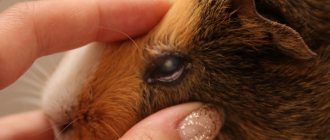Main reasons
Rodents are often susceptible to infectious and age-related eye diseases. If it is difficult for a hamster to open its eyes, it is imperative to figure out the cause of the problem, otherwise irreversible consequences will begin.
Allergy
Tearfulness can occur due to the consumption of exotic fruits and other unusual delicacies. Also the cause is the detergents used when processing cells, as they contain a large number of chemical compounds.
Unsanitary conditions
One of the common causes of eye diseases in rodents. Over time, microbes begin to multiply in the litter and bedding. And hamsters often sit and hide in them from people, so it is important to periodically change them.
Trauma and injury to the cornea
Hamsters can easily injure themselves. They can prick themselves on sharp oat straws, or a small particle of filler can penetrate under the eyelids. Inflammation of the cheek is also a factor in the onset of the disease. If several rodents live together in a cage, they can be injured during a fight.
With a fresh wound, the hamster squints due to the tearing of the eye. The affected area hurts, the pet is nervous, moves little and constantly hides. If the cornea is injured, microbes may enter and the eye may become sour.
Before the examination, it is necessary to clean the eyelids. When rinsing, do not use hydrogen peroxide or other liquids that harm the mucous membrane. If your eyes are stuck together, you need to soak your eyelids; under no circumstances try to force them open.
The easiest way is to soak it with a cotton swab dipped in boiled water. You cannot use regular cotton wool, as its fibers can remain on the eyelids or eyelashes and cause re-infection.
It happens that the eyelid is injured, in which case you need to lubricate it with tetracycline ointment twice a day.
Weak immunity
Eye ailments in hamsters can be in addition to tuberculosis, pneumonia and viral infections of the respiratory tract.
Conjunctivitis
Conjunctivitis is an inflammation of the mucous membrane. In general, this eye disease is quite common, and it can occur not only in rodents. If this disease appears, it often occurs in both eyes at once.
The causes of this disease include mechanical damage to the mucous membrane, infectious diseases, allergic reactions, for example, to disinfectants and cleaning agents, dust, dirt from linings and fillers.
If the inflammation occurs due to an allergic reaction, the discharge from the eyes will be clear. If conjunctivitis is the result of an infection, the discharge will be cloudy. From cloudy discharge, it will turn into purulent in the future.
In rodents, other infectious diseases usually appear along with conjunctivitis, most often this happens when the owner rarely cleans the cage and changes the lining. If the cage is rarely cleaned, the hamsters' eyes will fester regularly.
Inflammation is treated in the same way as eye injuries. First of all, in order not to provoke the appearance of the disease again, it is necessary to remove the lining from the cage; it is better to lay paper instead. This is necessary to maintain hygiene standards.
Afterwards, you need to wash and clean with disinfectants the entire cage and objects for the hamster to sleep and play with. After cleaning and treatment, the cage with the hamster must be removed from a bright place and the sun; after such an illness, the light will cause discomfort.
Eye diseases in hamsters
Problems in rodents can be identified by several signs:
- swelling and non-opening of the eyes;
- wet eyelids;
- tearfulness with purulent discharge;
- the appearance of a stye or bump;
- hair loss on the eyelids;
- redness of the inflamed area.
Based on these signs, it can be determined that the animal has a foreign infection. Due to the disease, rodents may stop eating and drinking. All eye ailments are divided into two groups: those resulting from injury and infectious.
Conjunctivitis
This is a disease associated with inflammation of the mucous membrane. This is the most common disease that affects both eyes.
There are several causes of conjunctivitis: infection and infection from another rodent. Without timely treatment, the disease progresses quickly: hamsters have poor spatial orientation, become spreaders of bacteria to other rodents, and may die.
Another reason is an allergy to food or “unhealthy” treats, for example, sweets, baked goods, etc. It is important to give hamsters a special balanced food that does not cause allergic reactions.
The main symptoms of conjunctivitis:
- redness;
- suppuration;
- increased moisture in the eyelids;
- restless behavior of the rodent;
- increase in body temperature;
- sticky eyelids.
If there is at least one symptom of the disease, it is considered that the infection has already entered the body. The discharge of pus indicates a progressive disease. If possible, it is advisable to show your pet to a veterinarian.
For home use, use a proven product - Albucid eye drops. 1 drop in both eyes three times a day. Positive dynamics are monitored from the third day of use. Along with instillation, you can wipe your eyes with a cotton pad once a day. It is not recommended to use other methods and means.
Care during illness:
- periodic change of litter;
- surface disinfection;
- monitoring the condition of the hamster;
- provision of quality food and clean drinking water;
- washing the cage and all rodent accessories.
Blepharitis
The cause of this disease is inflammation. The eyelids turn red and itching occurs. If not treated promptly, both eyes may close. The symptoms are the same as for conjunctivitis, but hair loss around the eye is added.
This is due to the fact that the hamster scratches the affected area. Treatment is similar to the previous disease, only tetracycline ointment is added. The main thing is to provide timely assistance and contact a veterinarian. If you have blepharitis, you need to provide your hamster with a diet and regularly disinfect the cage.
Abscess
If a rodent has a swelling of the eye and there is a clear difference in their size, then it may be an abscess. This disease is popularly called barley.
This is not a disease, but a symptom of shock - a purulent capsule that can hide deep in the hamster's body. The tissues around it become inflamed and become hot compared to other parts of the animal’s body.
Abscess symptoms:
- swelling of the eye;
- mucous discharge;
- inflammation of surrounding tissues;
- itching
The disease can only be cured in a veterinary hospital; it cannot be cured at home. Recovery occurs when the capsule is freed from pus.
Belmo
The disease is associated with the appearance of a light spot on the pupil of a hamster. The main factor is injury, sometimes cataracts. It happens that the stain covers the entire surface of the eye.
A veterinarian's consultation is required to determine the cause. This is a non-infectious disease and cannot be treated with medicine. The rodent will continue to live its usual life, but with a new disadvantage.
To prevent the disease, it is not recommended to place the pet’s cage in the sun and use bedding, which can harm the eyes. It is also not recommended to place hamsters that do not belong to the Djungarian species in the same cage.
Bacterial infections
This does not refer to a separate type of disease, but is a consequence of injury to the eyeball. The infection affects the general condition of the rodent.
Due to damage, bacteria multiply quickly and can penetrate inside the eye. In this case, surgical intervention, including removal, is possible, otherwise the bacterial infection can affect the entire body of the pet, and the hamster will die.
Cataract
This disease is called a metabolic failure in the lens. The end result is blindness. Causes of cataracts: nervousness, injury, old age and other ailments.
Eye drops will not help here, and surgical interventions are not used. The disease cannot be cured, but its occurrence can be prevented. To do this, you need to follow some recommendations:
- the hamster's cage should not be in the sun;
- do not give your pet sweets;
- feed plant foods: carrots, greens, zucchini;
- promptly treat eye diseases.
Glaucoma
This is an increase in the internal pressure of the organs of vision. The disease is accompanied by enlargement and bulging of the eyes, as well as severe pain. The diagnosis can be made by a doctor after measuring blood pressure.
The only treatment is enucleation, which can prevent severe pain. If the problem is ignored, the eye may burst. The cause of the pathology is unknown. Some veterinarians cite genetics.
Oncological diseases
An ordinary lump on a pet’s eyelid can turn out to be a tumor. Oncology can be caused by eyes of different sizes. Unfortunately, there is no effective treatment for the disease. For any disease, a visit to the veterinarian is necessary to establish a specific diagnosis and the reasons for its occurrence.
The doctor will also prescribe the right treatment. If the hamster's general condition worsens, you should not self-medicate.
What eye problems can hamsters have due to old age?
The appearance of a white spot on an animal indicates age-related changes in the body. The main diseases in old pets are cataracts and cataracts. Information on these diseases is given above in the article.
Due to old age, hamsters' eyes can fester. Unfortunately, there is no cure for age, neither for people nor for pets.
How to wash a hamster's eye at home
The procedure must be carried out very carefully, adhering to the following rules:
- take the hamster in your hand and wait until he is calm;
- in the case of a stuck eye, apply a cotton swab dipped in warm water to the affected area;
- when the eye opens, carefully remove mucous and purulent discharge;
- also use a cotton pad to remove dust and dirt from the eyelids.
The liquid should be at a comfortable temperature, since cold or hot can injure the wound. Frozen dirt should never be peeled off, as this can harm your pet.
What drugs are prohibited for treatment?
Human medications are not always suitable for rodents. For example, penicillin antibiotics are absolutely not suitable for them. Cephalosporins are also prohibited. Traditional medicine can also be dangerous for your pet.
Now you know about hamster diseases, how to treat them and how to help your pet. But it is important to remember about prevention. Spend time with your pet often to notice the first signs of behavior change. With proper care for your hamster, the risk of disease is low. Monitor your pet's diet, regularly clean and disinfect its cage - and your hamster will delight you with excellent health.
General rules of prevention
Eye allergies require not only eliminating the allergen, but also taking appropriate preventive measures . In order to avoid the occurrence of the disease, it is important to follow these rules:
- compliance with the rules of personal and general hygiene (especially in new places);
- no contact with allergen spreaders;
- periodic use of sorbent drugs;
- cleaning the nasal passages after returning from the street (often allergens enter the body with inhaled air);
- regular use of “Artificial Tear” drops for problems with the secretion of tear fluid, which washes away foreign microorganisms and particles from the eye and prevents the occurrence of allergic processes;
- We will take antihistamines not only during treatment, but also after it for 2-3 days;
- runny nose of allergic origin requires mandatory surgical treatment.
This is enough to prevent a repeat reaction, but given that the mechanisms of such a disease have not yet been fully studied, doctors do not give a complete guarantee that the allergy will not return.
Blepharitis
Blepharitis is a complication of advanced conjunctivitis. With this pathology, the inflammatory process completely engulfs the eyelids, causing them to become poisonous red. The fur begins to come out all over the face. The animal suffers from severe itching, the hamster constantly rubs its sore eyes. Also, the eyelids swell greatly, sometimes acquiring a bluish tint.
The treatment of this disease is similar to the treatment of conjunctivitis. However, drops alone are not enough. In addition to them, tetracycline ointment should be used. It is used to treat the eyelids from the outside 2-3 times a day.
Of course, before dripping medicine into the eyes, they must be washed and the accumulated pus removed. This can be done with chamomile infusion or tea.











